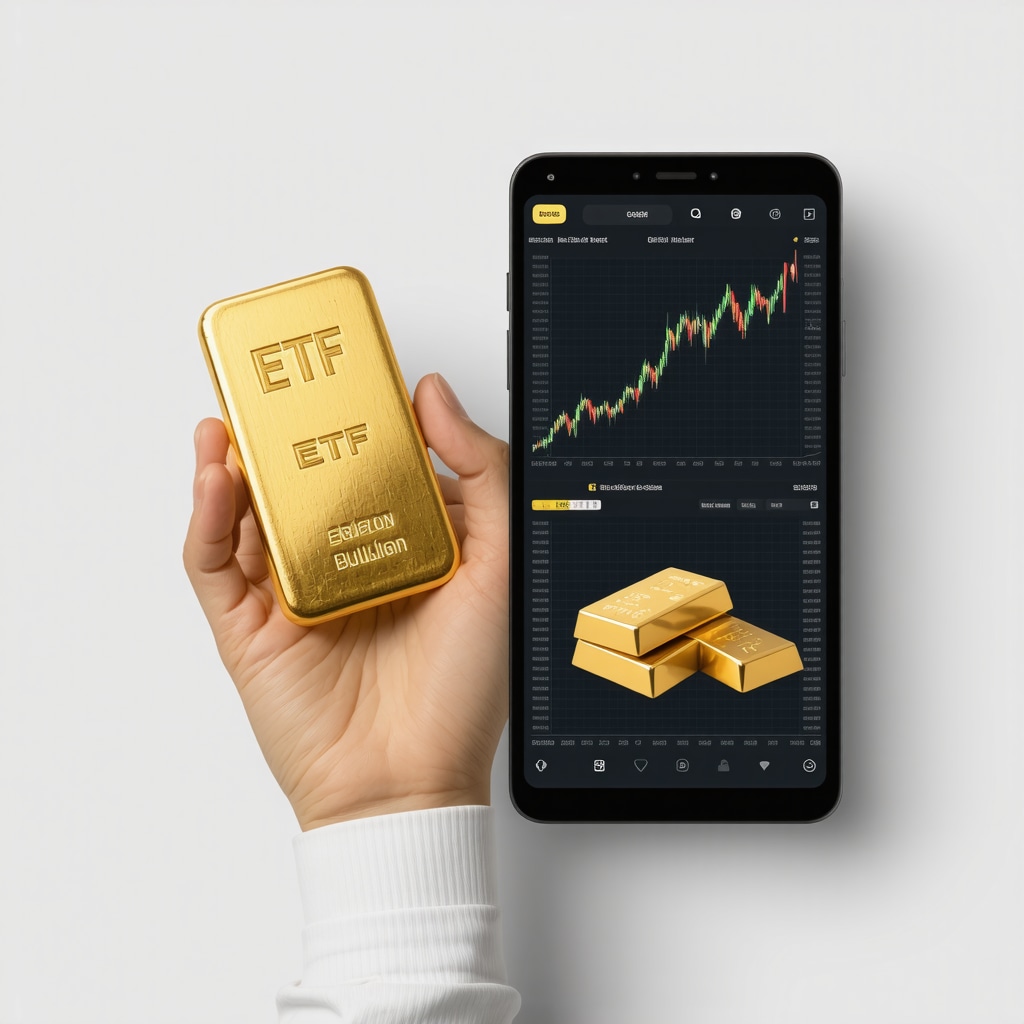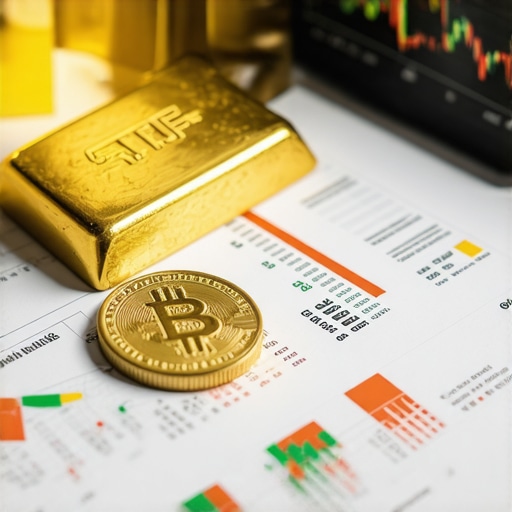Unveiling the Golden Dilemma: Bullion vs. ETFs as Your Investment Ally
In a world where economic uncertainty often shadows traditional markets, gold remains a beacon of stability. Yet, the question persists for savvy investors: should one embrace physical gold bullion or opt for the convenience and liquidity of gold ETFs? This discourse dives deeper than the surface, offering a nuanced exploration of these distinct investment vehicles, illuminating how each caters to different financial strategies and risk appetites.
The Tangible Treasure: Why Physical Gold Bullion Holds Timeless Appeal
Physical gold bullion—whether in coins or bars—embodies a tactile assurance that digital assets cannot replicate. Investors who prioritize sovereignty over their wealth often favor bullion for its intrinsic value and immunity from digital system risks. Bullion provides a direct hedge against inflation and currency devaluation, acting as a storied store of value that has weathered centuries of market turbulence.
Consider the example of a retiree seeking to safeguard assets from volatile stock markets; holding physical gold offers a comforting, tangible asset that can be stored securely, albeit with considerations for insurance and storage costs. This hands-on approach resonates with those valuing long-term preservation over short-term liquidity.
Paper Gold with a Digital Edge: The Strategic Advantages of Gold ETFs
Gold Exchange-Traded Funds (ETFs) have revolutionized access to gold investment by providing liquidity, diversification, and ease of trading akin to stocks. ETFs track the price of gold without requiring physical possession, making them attractive for investors who desire exposure to gold’s price movements without the complexities of storage or insurance.
For example, a portfolio manager aiming to rebalance asset allocation swiftly amid changing market conditions might prefer gold ETFs to capitalize on gold’s safe-haven status without the transactional friction of bullion. Moreover, ETFs often offer lower entry points and fractional investing opportunities, democratizing gold access.
What Are the Hidden Risks and Costs Between Bullion and Gold ETFs?
While bullion offers physical possession, it entails storage fees, potential liquidity constraints, and risks related to authenticity and theft. Conversely, gold ETFs expose investors to counterparty risks, management fees, and market volatility unrelated to physical gold’s intrinsic value. Understanding these trade-offs is crucial; for instance, during extreme market stress, ETFs may face liquidity crunches, whereas bullion might be hard to liquidate quickly at fair market value.
Balancing Act: Crafting a Diversified Gold Investment Strategy
Experienced investors often blend bullion and ETFs to harness the strengths of both. Physical gold secures foundation wealth, while ETFs provide agility and portfolio flexibility. This hybrid approach can optimize risk management, capitalizing on gold’s historical role as a portfolio hedge while accommodating modern investment demands.
For those intrigued by integrating gold into their retirement planning, exploring how to start a gold IRA offers invaluable guidance to leverage tax-advantaged accounts with gold exposure.
Engage with this evolving landscape by sharing your experiences or questions about gold investments below—your insights enrich our collective understanding.
Authoritative insights from the World Gold Council affirm gold’s enduring role in portfolio diversification and inflation protection, underscoring the importance of informed choices when selecting investment forms (World Gold Council – Gold Investment in 2023).
Reflecting on My Journey with Gold Investments: Lessons Beyond the Basics
When I first ventured into gold investing, the decision between physical bullion and gold ETFs felt daunting. The allure of holding a tangible asset was strong, but so was the appeal of the flexibility that ETFs offered. Over time, I learned that neither is inherently superior; rather, their effectiveness depends on personal goals, risk tolerance, and market conditions. For instance, during the economic turbulence of 2020, having a portion of my portfolio in physical gold provided me peace of mind as markets fluctuated wildly, while my ETF holdings allowed me to respond quickly to opportunities.
Storage Realities and the Emotional Connection to Physical Gold
One aspect often underappreciated until experienced firsthand is the responsibility that comes with storing physical bullion. I remember securing my gold bars in a home safe, only to realize the importance of insurance and discreet storage. This responsibility creates a unique emotional connection; the gold is not just an investment but a personal treasure, a safeguard that you literally hold in your hands. However, this also means liquidity can be slower compared to ETFs, which can be sold instantly through a brokerage account.
Why Do Some Investors Prefer ETFs Despite the Lack of Physical Ownership?
This question often comes up in conversations with fellow investors: “Why would someone choose a paper asset over something tangible like gold bars?” From my perspective, ETFs cater to those who value ease and speed. For example, during sudden market shifts, ETFs allow for rapid portfolio adjustments without worrying about the logistics of selling physical gold. Additionally, ETFs can be bought in fractional shares, making gold investment more accessible for those with limited capital. Yet, it’s crucial to remember that ETFs carry counterparty risks and fees, which can subtly eat into returns over time.
Integrating Gold into a Holistic Investment Strategy
One insightful practice I adopted is blending both bullion and ETFs to benefit from their complementary advantages. Physical gold acts as a fortress during uncertain times, while ETFs provide the nimbleness needed for tactical moves. If you’re curious about how to structure such a hybrid portfolio, exploring guides like step-by-step gold IRA setup can offer practical steps to include gold in your retirement plans efficiently.
Moreover, the World Gold Council’s research highlights gold’s resilience and diversification benefits, reinforcing why it remains a cornerstone in many portfolios (World Gold Council – Gold Investment in 2023).
How Do You Decide Which Gold Investment Fits Your Personal Financial Journey?
Deciding between physical gold and ETFs is deeply personal. Reflecting on your investment timeline, liquidity needs, and comfort with custodial risks is essential. Have you experienced moments where holding physical gold brought you reassurance, or times when ETF liquidity helped you pivot quickly? Sharing your stories can illuminate this nuanced decision for others navigating similar crossroads.
Feel free to join the conversation by commenting below or sharing your experiences with gold investments. If you’re eager to dive deeper, check out related insights on best physical gold investment options and gold price forecasts for 2026 to stay ahead in your investment journey.
Decoding the Tax Implications: Navigating Complexities in Bullion and ETF Investments
Taxation remains one of the most intricate aspects when investing in gold, often overlooked by novice investors yet pivotal in net returns. Physical gold bullion is typically classified as a collectible in many jurisdictions, subjecting gains to higher capital gains tax rates compared to standard securities. For example, in the United States, gains on bullion held over a year are taxed at a maximum rate of 28%, exceeding the typical 15–20% rates applied to most long-term investments.
Conversely, gold ETFs generally enjoy preferential tax treatment akin to other exchange-traded securities, depending on the fund structure and domicile. However, complexities arise with synthetic ETFs or those that use derivatives, potentially triggering ordinary income tax on distributions. Understanding these subtleties is essential for optimizing after-tax returns and aligning investment choices with your broader financial plan.
For detailed tax rules, investors should consult resources such as the IRS Publication 550: Investment Income and Expenses, which offers authoritative guidance on collectibles and securities taxation.
Mitigating Counterparty and Custodial Risks: Advanced Safeguards for Gold Investors
While gold bullion owners face physical risks like theft or loss, gold ETF investors confront counterparty risks embedded in fund management, custodianship, and regulatory frameworks. The 2008 financial crisis underscored the potential vulnerabilities of paper gold, where liquidity evaporated and trust in counterparty solvency was tested.
Advanced investors mitigate these risks through diversification across multiple custodians, selecting ETFs with transparent physical backing, and scrutinizing audit reports that verify gold holdings. Additionally, owning allocated bullion accounts with reputable depositories combines physical ownership with professional custodianship, bridging the gap between bullion and ETFs.
How Can Investors Balance Liquidity and Security When Choosing Gold Investment Vehicles?
This nuanced question captures the essence of strategic gold investing. Balancing liquidity and security requires an investor to evaluate their timeframe, risk tolerance, and market access. Physical bullion offers unmatched security and intrinsic value but lacks instant liquidity. ETFs provide immediate tradability but depend on financial intermediaries and market functioning.
One sophisticated approach involves maintaining a core position in allocated bullion stored in insured vaults while using ETFs tactically for portfolio rebalancing and liquidity needs. This dual-layer strategy enhances resilience against market shocks and operational risks.
Exploring Technological Innovations: Blockchain and Tokenized Gold as the Future of Gold Investment
Recent advancements in blockchain technology have introduced tokenized gold platforms, offering a novel hybrid between physical ownership and digital convenience. Tokenized gold represents ownership of allocated bullion through blockchain tokens, promising transparency, fractional ownership, and seamless transferability without traditional custodial constraints.
However, regulatory clarity and standardization remain evolving challenges, and investors should exercise due diligence when engaging with these emerging tools. Research by the Bank for International Settlements highlights both the potential and risks inherent in digital asset-backed securities, including tokenized commodities.

Leveraging Gold in Portfolio Hedging: Integrating Macroeconomic Indicators with Investment Timing
Advanced portfolio managers refine gold investment timing by correlating macroeconomic indicators such as real interest rates, inflation expectations, and geopolitical tensions. Gold’s inverse relationship with real yields and its safe-haven demand during crises underpin tactical allocation shifts.
Incorporating quantitative models that trigger gold purchases during real yield troughs or spike geopolitical risk indices can enhance portfolio resilience. This approach necessitates continuous market intelligence and a disciplined investment framework to avoid emotional biases.
Engage with these complex strategies by exploring our advanced guides and expert commentaries to elevate your gold investment acumen and safeguard your financial future with precision and confidence.
Demystifying Tax Nuances: Strategic Considerations for Bullion and ETF Investors
In-depth comprehension of tax implications is indispensable for refining gold investment strategies. Physical gold bullion, often categorized as a collectible asset, attracts higher capital gains taxes compared to conventional securities, imposing a significant consideration for long-term investors. For instance, in the United States, bullion gains may be taxed at up to 28%, contrasting with the preferential rates applicable to equities. Conversely, gold ETFs generally benefit from more favorable tax treatment resembling that of standard investment funds, though the complexity of synthetic ETFs and derivative-based products may introduce ordinary income tax liabilities on distributions.
Investors aiming to optimize after-tax returns should engage with authoritative resources like the IRS Publication 550: Investment Income and Expenses, which delineates tax treatments pertinent to collectibles and securities, thereby facilitating informed decision-making aligned with individual fiscal circumstances.
Mitigating Custodial and Counterparty Risks: Advanced Safeguards in Gold Investment
While physical bullion investors primarily confront tangible risks such as theft and storage, ETF investors must navigate intricate counterparty and custodial vulnerabilities inherent in fund management and regulatory frameworks. The liquidity freeze during the 2008 financial crisis exemplifies these systemic risks, underscoring the necessity for meticulous due diligence. Sophisticated investors often diversify custodial relationships, prioritize ETFs with transparent physical backing, and rigorously analyze audit disclosures substantiating gold reserves. Allocated bullion accounts with reputable depositories serve as a hybrid solution, amalgamating physical asset security with professional custodianship.
How Can Investors Balance Liquidity and Security When Choosing Gold Investment Vehicles?
Balancing liquidity and security in gold investments demands a nuanced strategy that aligns with the investor’s temporal horizon, risk tolerance, and operational preferences. Physical bullion offers unparalleled intrinsic security but at the expense of immediate liquidity. Conversely, ETFs afford seamless tradability yet introduce dependencies on financial intermediaries and market conditions. An advanced approach entails maintaining a core allocation in insured, allocated bullion vaults complemented by tactical utilization of ETFs for agile portfolio rebalancing, thereby fortifying resilience against market disruptions and operational contingencies.
Harnessing Blockchain and Tokenized Gold: Pioneering the Future of Gold Ownership
The convergence of blockchain technology with gold investment heralds a transformative era through tokenized gold platforms. These innovations facilitate fractional ownership, enhanced transparency, and frictionless transferability by representing allocated bullion via blockchain tokens, circumventing traditional custodial limitations. Nevertheless, regulatory ambiguity and the nascent stage of standardization present challenges requiring prudent investor scrutiny. The Bank for International Settlements provides a comprehensive analysis of digital asset-backed securities, elucidating both their disruptive potential and inherent risks.

Strategic Portfolio Hedging: Integrating Macroeconomic Signals with Precise Gold Allocation
Elite portfolio managers exploit sophisticated macroeconomic indicators such as real interest rates, inflation trajectories, and geopolitical volatility to fine-tune gold allocation timing. Gold’s inverse correlation with real yields and its safe-haven demand during crises enable tactical shifts that enhance portfolio robustness. Employing quantitative models that trigger acquisitions during real yield troughs or geopolitical risk surges embodies a disciplined, data-driven methodology that mitigates emotional biases and optimizes risk-adjusted returns.
For those seeking to elevate their gold investment proficiency, delving into advanced analytical frameworks and expert commentaries can unlock nuanced insights pivotal to securing wealth amidst evolving global uncertainties.
Engage with Expert Insights to Elevate Your Gold Investment Approach
Embracing the complexities of gold investment—from taxation and risk management to emergent technologies—empowers investors to architect resilient, adaptive portfolios. We invite you to explore these advanced perspectives, share your experiences, and pose challenging questions that deepen collective expertise. By integrating cutting-edge strategies and leveraging authoritative resources, you position yourself at the forefront of gold investment innovation and security.
Frequently Asked Questions (FAQ)
1. What are the primary differences between physical gold bullion and gold ETFs?
Physical gold bullion represents tangible ownership of gold bars or coins, offering intrinsic value and protection against digital system risks but involves storage and insurance costs. Gold ETFs are financial securities that track gold prices, providing liquidity, ease of trading, and fractional ownership without physical possession, but they carry counterparty and management risks.
2. How do tax implications differ between bullion and gold ETFs?
In many jurisdictions, physical gold bullion is treated as a collectible, often subject to higher capital gains tax rates (e.g., up to 28% in the U.S.), while gold ETFs generally receive more favorable tax treatment similar to stocks or funds. However, synthetic ETFs may trigger ordinary income tax on distributions. Consulting specific tax codes like IRS Publication 550 is essential for personalized planning.
3. What risks should investors consider when holding physical gold?
Investors face tangible risks including theft, loss, authentication challenges, and storage expenses. Secure storage solutions and insurance are critical to mitigate these risks. Moreover, liquidity can be slower compared to ETFs, especially during urgent sell requirements.
4. Are gold ETFs safe during financial crises?
While gold ETFs provide liquidity and convenience, they carry counterparty risks linked to fund managers and custodians. During extreme market stress, ETFs may experience liquidity constraints or price deviations from physical gold. Selecting ETFs with transparent physical backing and audited reserves helps mitigate these concerns.
5. How can I balance liquidity and security in my gold investments?
A balanced approach involves maintaining a core allocation in allocated physical bullion stored in insured vaults for security, complemented by tactical positions in gold ETFs for quick portfolio adjustments and liquidity. This hybrid strategy leverages the advantages of both investment vehicles.
6. What is tokenized gold and how does it differ from traditional gold investments?
Tokenized gold utilizes blockchain technology to represent ownership of allocated physical gold through digital tokens, enabling fractional ownership, transparency, and seamless transfers without traditional custodial intermediaries. However, regulatory frameworks are still evolving, and investor due diligence is paramount.
7. How do macroeconomic indicators influence gold investment timing?
Gold prices typically have an inverse relationship with real interest rates and rise amid inflationary pressures and geopolitical uncertainty. Advanced investors use quantitative models incorporating these indicators to tactically adjust gold allocations, enhancing portfolio resilience and optimizing risk-adjusted returns.
8. Can I include gold in my retirement accounts?
Yes, gold can be integrated into tax-advantaged retirement accounts such as Gold IRAs. These accounts allow investors to hold physical gold or gold-backed securities within a retirement framework, combining tax benefits with gold’s diversification properties. Proper setup and custodian selection are critical.
9. What are the costs associated with gold ETFs versus bullion?
Gold ETFs incur management fees and potential bid-ask spreads, which gradually impact returns. Physical bullion involves upfront premiums over spot price, storage fees, insurance costs, and potential selling commissions. Evaluating total cost of ownership is essential for long-term investment decisions.
10. How can I verify the authenticity and backing of a gold ETF?
Investors should review ETF prospectuses, audit reports, and custodial arrangements. ETFs with allocated physical gold holdings, transparent reporting, and reputable custodians reduce counterparty risks. Regulatory filings and third-party audits provide additional verification.
Trusted External Sources
- World Gold Council (WGC): A leading authority on gold market data, investment trends, and research, providing in-depth analysis on gold’s role in portfolios and market dynamics (gold.org).
- Internal Revenue Service (IRS) Publication 550: Offers comprehensive guidance on the tax treatment of investment income, collectibles, and securities, crucial for understanding gold taxation nuances (irs.gov).
- Bank for International Settlements (BIS): Provides authoritative research on financial markets, including digital asset-backed securities and tokenized commodities, essential for evaluating emerging gold investment technologies (bis.org).
- Investment Company Institute (ICI): Offers detailed data and analysis on ETFs, including structure, risks, and investor protections, helping to assess gold ETF products (ici.org).
- SEC Filings and ETF Prospectuses: Primary documents providing transparency on fund holdings, management fees, and custodial arrangements, critical for due diligence on specific gold ETFs.
Conclusion
Navigating the choice between physical gold bullion and gold ETFs requires a sophisticated understanding of each vehicle’s benefits, risks, costs, and tax implications. Physical bullion offers tangible security and historical resilience, ideal for investors prioritizing sovereignty and long-term preservation. Conversely, gold ETFs deliver liquidity, ease of access, and portfolio flexibility, appealing to those favoring agility and lower entry barriers.
Advanced strategies often blend both forms to harness their complementary strengths—allocating core wealth in secured bullion while utilizing ETFs for tactical portfolio management. Emerging innovations like tokenized gold hold promise for the future, marrying physical backing with blockchain-enabled convenience, though regulatory and operational due diligence remain paramount.
By integrating macroeconomic insights, rigorous risk management, and informed tax planning, investors can optimize gold’s role as a portfolio hedge and wealth preserver. We encourage you to apply these expert perspectives, share your own investment experiences, and explore further resources to deepen your mastery of gold investment strategies.










